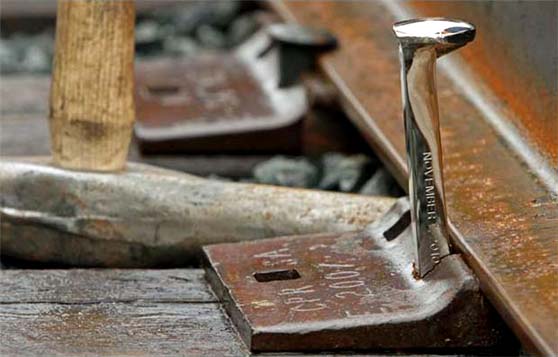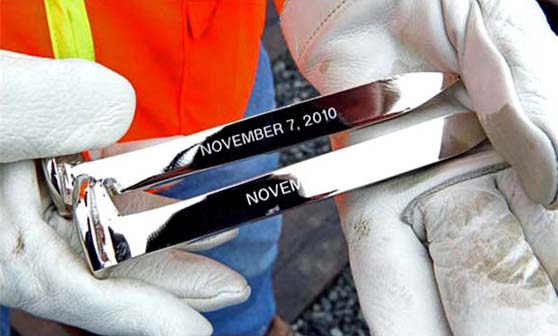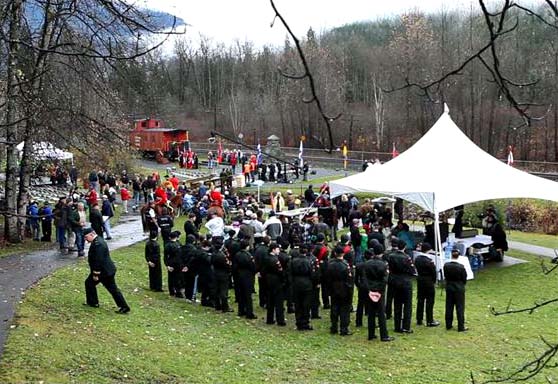
8 November 2010
CPR Hammers Home 125 Years of History

Chromed steel spikes await to be hammered in an official ceremony at Craigellachie, Britiish Columbia, to
commemorate the 125th anniversary of the Last Spike on Sunday 7 Nov 2010. The Last Spike, driven 125 years ago to the day on 7 Nov 1885, marked the completion
of the Canadian Pacific Railway, considered the single most important construction project in Canadian history.

Chromed steel spikes await to be hammered in an official ceremony at Craigellachie.

Craigellachie British Columbia - On 7 Nov 1885, Donald Alexander Smith, a financier and director
of the Canadian Pacific Railway, stood over an iron railway spike that symbolized the unity of a nation and, lowering a hammer with what must have been
considerable force, unceremoniously bent Canada's most celebrated piece of metal, rendering it useless.
 The famed "Last Spike," immortalized in word, film, song, and in one of Canada's most iconic photographs, had to be pried out and replaced.
The famed "Last Spike," immortalized in word, film, song, and in one of Canada's most iconic photographs, had to be pried out and replaced.
On the do-over, Smith got it right.
On Sunday, the 125th anniversary of the driving of the Last Spike, CPR president and CEO Fred Green drove one of three chrome-plated spikes at this historic
site west of Revelstoke, on the same spot as Smith.
None bent.

The official ceremony at Craigellachie, Britiish Columbia, to commemorate the 125th anniversary of the Last
Spike on Sunday 7 Nov 2010.
But Sunday's ceremony, in the minds of some, was far from perfect.
With no descendants of Chinese workers represented, one historian said it was a missed opportunity for the CPR and another slight to Chinese migrant workers
who died, by some estimates, at the rate of four per mile in sections where they worked, more than any other group.
"For a corporation that has so prospered over the generations because of the back-breaking labour of the Chinese Canadian workers, they have to go further
than tokenistic acknowledgment of the Chinese role," said Bradley Lee, a Last Spike historian.
Green disagrees, saying the railway has made significant gestures to the Chinese community.
At the ceremony, he announced a $500,000 contribution to digitize a collection of 21,000 historical books and documents on Chinese immigration donated to the
University of British Columbia by retired surgeon and former head of the department of surgery at UBC, Dr. Wally Chung, whose parents arrived in Canada in
1891, six years after the railway was competed.
Green said Chung was invited but health issues prevented his attendance.
"Over the years, CP has specifically recognized the Chinese labourers who were fundamental in the construction of the western British Columbia section of
the railway," Green said in his remarks.
Monuments and displays erected by CP along the route "allow present-day Canadians to better understand the contribution these brave people played,"
he said, also acknowledging the role of Ukrainian, Italian, and Japanese workers on the line.
"We know that all who helped complete the railway suffered through hard conditions and, tragically, some workers did die.
But you must know that lessons learned from this experience have guided CP and made us into the safest railway in North America today."
The plight of Chinese workers, however, remains particularly sensitive.
Last week, a group of Chinese Canadians learned that a ceremonial spike given by them to Prime Minister Stephen Harper in 2006 has been sitting on a shelf in
the Prime Minister's office, instead of being placed on prominent display on Parliament Hill as they had thought.
Harper on Sunday issued a statement on the 125th anniversary honouring those who died.
He specifically mentioned the Chinese "head tax", calling it "a race-based entry fee" for which the government officially apologized in
2006.
The misplaced spike in Harper's office is in keeping with a history of indignities to the two official last spikes that emerged from the original 1885
ceremony.
The bent spike driven by Smith was destroyed when it was cannibalized for pieces of jewelry given to CP directors and their wives, according to CP's manager of
heritage, Bob Kennell.
The second spike that Smith drove was also partially used for jewelry.
It currently comprises part of the collection of the Canadian Science and Technology Museum in Ottawa and is on display with a chunk missing.
That, anyway, "is our version of the story," Kennell says.
Other versions of what happened to the original spike abound, says Cathy English, curator of the Revelstoke Museum and Archives.
"It's hard to sort out," says English.
"The story that seems closest to the truth is that the first spike was destroyed for jewelry and the second spike is the one in the possession of the
science museum in Ottawa."
The second spike was also removed from the site, fearing it would be stolen by souvenir hunters, and was replaced by a third spike that remained.
The CPR, nearly broke after the construction of the railway, could not afford a traditional gold spike.
A silver spike was made for the ceremony, but never made it to Craigellachie.
English said its whereabouts is unknown.
Among those in attendance Sunday was Edward Harris, from North Andover, Mass., who brought with him a lapel pin encrusted with pearls, apparently made from one
of the original spikes.
"It's a chunk of spike, but which spike I'm not sure," Harris said.
His father, Boston financier George Ropes Harris, was front-and-centre in the famed photograph taken in 1885 by Alexander J. Ross.
Harris is standing to the left of teenager Edward Mallandaine, the so-called "Craigellachie Kid," who muscled his way into history.
Mallandaine is seen peeking over the shoulder of Smith in the Ross photo.
In addition to the $500,000 donation to UBC, Green also announced another $1.6 million in donations including $200,000 for First Nations scholarships, $100,000
to a military families fund, a $250,000 endowment to Simon Fraser University, and a $1 million endowment to the University of Calgary's Haskayne School of
Business and the university's Van Horne Institute, a transportation regulatory think-tank.
The biggest cheer from the crowd, however, came when Green announced free iPods for a group of elementary school students from Revelstoke who sang Gordon
Lightfoot's Great Canadian Railway Trilogy.
He also announced a $30,000 grant to equip a Revelstoke school with new computer equipment, capping a total of $2.13 million in grants and endowments.
After the announcements, one woman in attendance was moved to remark, "Wow, the railroad barons really rolled into Revelstoke today."

|